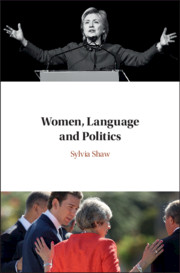Book contents
- Women, Language and Politics
- Women, Language and Politics
- Copyright page
- Dedication
- Contents
- Figures
- Tables
- Acknowledgements
- Abbreviations
- Transcription Conventions
- 1 Introduction
- 2 Gender and Language in Political Institutions
- 3 Women’s Linguistic Participation in a Traditional Male-Dominated Forum – The UK House of Commons
- 4 Women’s Linguistic Participation in the New Devolved Assemblies of the UK
- 5 Barriers to Women’s Participation in Politics
- 6 Case Study: Theresa May
- 7 Case Studies: Julia Gillard and Hillary Clinton
- 8 Women, Language and Politics
- Book part
- Notes
- References
- Index
7 - Case Studies: Julia Gillard and Hillary Clinton
Published online by Cambridge University Press: 08 May 2020
- Women, Language and Politics
- Women, Language and Politics
- Copyright page
- Dedication
- Contents
- Figures
- Tables
- Acknowledgements
- Abbreviations
- Transcription Conventions
- 1 Introduction
- 2 Gender and Language in Political Institutions
- 3 Women’s Linguistic Participation in a Traditional Male-Dominated Forum – The UK House of Commons
- 4 Women’s Linguistic Participation in the New Devolved Assemblies of the UK
- 5 Barriers to Women’s Participation in Politics
- 6 Case Study: Theresa May
- 7 Case Studies: Julia Gillard and Hillary Clinton
- 8 Women, Language and Politics
- Book part
- Notes
- References
- Index
Summary
In this second set of case study I examine the performances and representation of Julia Gillard (Australian Prime Minister 2010–2013) and Hillary Clinton (democratic presidential candidate, 2016 US election). I start by analysing adversarial language and sexism in Julia Gillard’s parliamentary performances in the Australian House of Representatives. These highly adversarial exchanges with Tony Abbott are extremely confrontational and adversarial. As with Theresa May, this discussion is developed into an analysis of a critical gendered moments when Gillard delivered her famous ‘sexism and misogyny speech’, which was followed by gendered media representations of the performance, and accusations that she ‘played the gender card’. Secondly, the case study of Hillary Clinton analyses critical gendered moments in the US televised debates against Donald Trump in 2016. Clinton is found to have performed well against Trump, given that she is positioned in gendered ways in relation to his sexist discourses. However, her political success is identified as resting on her ability to negotiate a tightrope of double binds – for example emotionality vs toughness – which mean that she is constantly attending to and negotiating her femininity in terms of both her appearance and her behaviour.
Keywords
- Type
- Chapter
- Information
- Women, Language and Politics , pp. 211 - 242Publisher: Cambridge University PressPrint publication year: 2020

